Marsh of Txingudi
Although little has been written about Txingudi, it is currently considered the most important humid environment in Gipuzkoa, at the level of the Basque Country, being the second place after Urdaibai. However, although the situation of Urdaibai from the maintenance point of view is better than that of Txingudi, analyzing the number of bird species of both sites it is found that the Txingudi is greater.
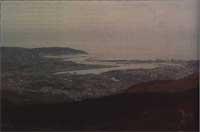
Taking this last data into account, it is necessary to present a more comprehensive information about Txingudi, in order to avoid the negligence that has suffered so far and to deal with its deterioration. We cannot forget that Txingudi has been recognized as an environment of international importance by many organizations. Among them are three: International Waterfowl Research Bureau de Slinbridge (England), B.I.R.O.E. of France and which is the "Federation of Friends of the Earth" of Madrid.
Before giving details, perhaps it would be appropriate to mention the importance of estuaries to understand the movements that have occurred in defense of these media. The importance of estuaries is based on two main factors:
- In estuaries, the mixture of fresh (continental) and salty (marine) waters has forced to adapt the vegetation and fauna of the marshes to variable salinity conditions, creating species of great ecological importance.
- River dynamics, on the other hand, causes in estuaries an important accumulation of nutrients and organic matter, with a very high productivity in these ecosystems. This benefits the rich trophic chains, and that would be the reason for the abundance of migratory birds.
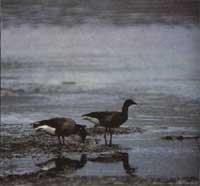
In addition to these characteristics, other factors must be taken into account in Txingudi to understand its importance:
- Txingudi is the last relatively well preserved marsh of Gipuzkoa (not forgetting Zumaia, of course), given the harsh attacks that have suffered these areas on our coast. This directly affects migratory birds, which must travel longer and longer distances to look for rest areas.
- On the other hand, Txingudi is in an important migratory axis, since the Pyrenees become an impassable barrier. Therefore, the Pyrenees and the Bay of Biscay produce a funnel effect on the migration of birds, in whose hole is Txingudi.
Marsh
The most attractive ecosystems that we can find in Txingudi would be the marsh and the beach. We left this last for another occasion and now we try to study Txingudi's marsh.

The most important marsh of Gipuzkoa can be divided into three sections. Not by its natural nature, but by its separation by human action. These three sections are the islands of Bidasoa, Plaiaundi and Jaizubia, and the area of Belenia.
Bidasoa Islands
The first section consists of the islands Hiru Kanale, Galera and Santiago Aurrera that the river Bidasoa presents before its mouth in the river Jaizubia. These islands are made up of materials provided by the river, so they are not static, as they are constantly receiving new losses of land and flows. In addition, as tides flood large plots twice a day, the vegetation and fauna of these islands have adapted to the changing conditions of salinity and irrigation, with species typical of the marshes.
This vegetation is largely composed of herbaceous species. The most abundant are species of the families Juncaceae (reeds), Gra mineae (with straw) and Cyperaceae (papyri).
However, depending on the influence of the sea tides and the periodic floods that occur in the river in the different sections of these islands, the marsh can be divided into two parts: the first, located below, so it is often submerged. The second, on the other hand, being higher, is drier and does not remain so often submerged.
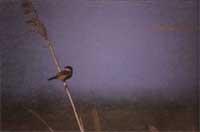
This difference makes the species of halophyll vegetation (adapted to conditions of high salinity) that we can find in these two sections also different. That is, the most important species observed in a plain that is often submerged are: Salicornia g. Europaea, Aster tripolium, Spergularia media and some species of the genera Spartina, all adapted to live underwater many hours a day.
Above, the influence of sea tides is less, so the changes are less violent and this favors the appearance of more species. Like Juncus maritimus, Scirpus maritimus, Halimione portulacoides, etc.
In this study of vegetation you can not ignore the abundance of reeds (Phragmites comunis) of great ecological importance both in the islands of the Bidasoa as in Plaiaundi and Jaizubia. These reeds are necessary for the feeding and reproduction of numerous bird species.
Special mention deserves the shrub layer of these islands, which is formed by a species imported from Baccharis halimifolia. This species, since its introduction in the islands, has achieved a great expansion, since its growth is currently worrying and can cause eutrophication problems in the marsh.

In addition to the intrinsic importance of this halophilous vegetation, considering that many of the plant species described in this estuary have not appeared anywhere else in Gipuzkoa, the importance of maintaining and recovering this marsh will be considered. Not forgetting the attraction of Txingudi from the ornithological point of view.
Once the vegetation of these islands is analyzed, it is essential to study the animals, delving into the description of the birds of Txingudi, which has decided to recognize Txingudi as an environment of international importance.
As mentioned above, the special characteristics of estuaries contribute to the high productivity of these ecosystems by creating rich trophic chains. Therefore, although the most spectacular testimonies of these chains are birds, we must not forget that the base of these chains is silt and other invertebrates, such as polychaetes, molluscs, crustaceans and others that inhabit the water, which are the foods that make up the diet of birds and fish.
However, as a means of feeding, the islands lack importance for other places in the bay (Plaiaundi, Belenia, etc. ), but the isolation of these islands has made them the most suitable resting place for birds.
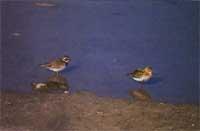
In general, Txingudi birds can be divided into two groups: nesting and migrants, with the highest percentage of migrants (90%). However, due to the isolation conditions of the Bidasoa islands, human pressure is lower, allowing a higher percentage of nesting.
Among the nesting agents stand out carrizales (Acrocephalus sp. ), benarrizas (Locustella sp. ), riachuelo (Cettia cetti), etc. However, as mentioned above, the greatest diversity is found in migrants, most of them wintering. Among them are the green marsh (Emberiza schoeniclus), the red joke (Erithacus rubecula), the kingfisher (Alcedo atthis), the common turtle (Streptopelia turtur), the quail (Coturnix sp. ), cold (Vanellus vanellus), etc.
On the other hand, the presence of limícolas (birds that feed on silts) is also remarkable, but due to their greater presence in other places of the Tuario is, these birds will be studied later.
Few, but perhaps more important, have been frequent in these islands the presence of the common crane (Gros grus), the royal heron (Ardea cinerea), the spatula (Platalea leucorodia), the wild duck (Anas platyrhynchos), the common cerceta (Anas crecca), the common copenhagen (Fullatra, Polluchopo), Blue. ). Finally, we cannot fail to mention some species of gulls that appear throughout the year in Txingudi: Argéntea Gull (Larus cachinnans), Shadowy Gull (Larus fuscus) and Reidora Gull (Larus ridibundus).
Plaiaundi and Jaizubia

The meeting point of the Jaizubia and Mendelu streams with the Bidasoa River is known as Plaiaundi. It is currently in a situation of serious deterioration, but it is one of the most important places from the ornithological point of view. In recent years, the negligence of the Irun City Council has been the cause of the strong attacks, such as the systematic drying of large sections of marsh by uncontrolled fillings or the illegal dredging of two companies located in it. Within this last point, it is worth mentioning that some 20 years ago these companies had extinguished an island of limos of 4 hectares that was in front of Plaiaundi, being the most important part for the feeding of lilies.
At present it is still dredging, it is not possible to recover the island until this action is suspended.
However, in some areas of the reed that has preserved Plaiaundi it is usually not difficult to observe some species of birds adapted to two of them. The same happens in the reeds that have been preserved on the banks of the Jaizubia River, considering that its importance is less in this valley.
Some species of nesting birds in the reeds of these two regions, except in the case of Txingudi, are not found in any other. Among the nesting agents are the carrizales (Acrocephalus sp. ), chickens (Galiinula chloropus), pilgrim rascón (Rallus aquaticus), carrascas (some species of the sylviidae family), etc. But the importance of these reeds does not end in nesting, but also for some migrants they become areas of rest and food during migratory periods. That is why we can often see papaurdinas (Luscinia svecica), small and common puddles (Lymnocriptes minimus and chicken hen), kingfisher (Alcedo atthis), chickens (Porzana sp. ), etc.
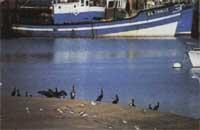
Although the importance of these reeds is evident, it cannot be said to be the only attraction in this area, since the beaches of silts that are generated are necessary for the feeding of some fish and birds. As mentioned above, these highs have a high concentration of nutrients and organic matter, with a high biological productivity. This makes the invertebrate and vertebrate populations that we can find in these areas important. As for the fish, in the waters that cover these beaches of silts appear typical fish of saline estuaries: sea trout (Psalm trutta trutta trutta), common bass (Dicentrarchus labrax), saucer (Platichthys flecus flesus), corcón (Chelun labrosus), barina de peñas (Luanguetilla, etc.
Inside the birds we find three types of birds: limousines, analogs (swans, ducks and geese) and fishermen (with local fish as food).
Among the first, the most abundant are the correlims (Calidris sp. and Pluvialis sp. ), bernagorriak and kulixak (Txinga sp. and Limosa sp. ), kurlints (Numenius sp. ), chorlitejos (Charadrius sp. ), etc. Among them it is normal to find groups of reidora gulls (Larus ridibundus).
Among the analogs are Anser (geese), Tadorna (paitas), Anas (ducks and pigs), Aythya (porrones). The birds that we can find inside the fishermen are species of the family ardeidae (herons and egrets).
The island of birds and silts of Belenia

With the dredged materials for the construction of the fishing port of Hendaia, in the area of Belenia a residual island called Txori-uharte was formed. This meant a change in the dynamics of the environment currents, creating around the island a marsh of Belenia, of great importance for the birds of Txingudi. Therefore, although this island plays a fundamental role as a resting place for birds, it is not comparable to the importance of the adjacent marsh, where feeds the largest proportion of birds passing through Txingudi.
From the botanical point of view, there are also notable differences between island and marsh: while the vegetation of the island is composed of several species of dunes, except for herbs and rudenal shrubs, the marsh is constituted by the species of halophyll grass mentioned for the islands of the Bidasoa, among which the most abundant are some of the species of the genus Spartina. Due to the rapid growth of these species, in a few years the surface covered by these herbs has increased considerably, achieving the consolidation of the marsh. It is noteworthy, due to its proximity to the sea, the herbaceous species Zostera noltii, adapted to live immersed for a long time, which is only found here in all Txingudi.
But the most attractive of Moreno are the birds that can be seen in it, since in this area they find the necessary food and, above all, the tranquility that is difficult to find elsewhere. For this reason, in recent years, Belenenia has become the best point of view for birds.
All birds that pass through the Txingudi can find on this island the necessary rest in their migrations, normally in this area human pressure is lower than in other areas of the marsh.
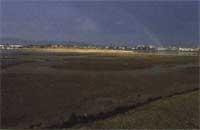
In addition to all types of lilies on the residual margins of the island, some species of the family laridae (gulls and gulls), spatula (Platalea leukorodia), cormorants (Phalacrocorax Garbo), charranes (Sterna sp.) Numerous species of anatids also appear. In the middle island herbaceous zone, on the contrary, it is not difficult to find some species of the family ardeidae (herons and egrets) that are conflictive (Gallinago sp. ), swamp owl (Asio flammeus) and some summer passerformes (Anthus sp.) fins (alaudidae), etc. see. In addition, it has been shown that in recent years the specimens of the species Great Kurlinta (Numenius arquata) and Common Executioner (Tringa totanus) have used the island as a place of sleep in winter.
The function of the limes of Belenia, on the other hand, would be to satisfy the nutritional needs of the birds that are at rest in the islands of the Bidasoa and in the neighboring island, among which the lilies and the analogs stand out. It can be said that the greatest diversity of bird species of all Txingudi is manifested in these limes, since all the species of European lilies have been described. Periods of greater diversity coincide with migration after tracking, while in winter diversity decreases, increasing the number of specimens per species.
Finally, we will expose some species of birds worthy of mention and observed in Belenia, which are rare in our marshes. The main ones would be the black stork (Ciconia nigra), the spatula (Plataiea leucorodia), the brown branta (Branta bernicla), the small heron (Egretta garcetta) and the osprey (Pandion haliaetus).
Attacks
Although the first thing that occurs to us after analyzing the biological importance of the Txingudi marsh is that it is necessary to promote the conservation and recovery of this privileged environment, it must be emphasized that the future of this marsh is very hard, since they have been wasted in projects that have not completed all the good institutional intentions. In 1983, commissioned by the Basque Government, the Aranzadi science society studied Txingudi in depth. It proposed measures for the recovery and conservation of the Bidasoa River marsh.

However, this project did not advance and the Txingudi disaster continued due to the negligence of the institutions. In 1989, under pressure from certain environmental movements, the Irun City Council proposed to the Basque Government the realization of a new recovery project, since that of Aranzadi was obsolete, since for seven years the estuary suffered strong attacks.
On this occasion, the company Ingemisa has been in charge of developing the project. Initially it was only for Irun. However, taking into account the good reception of the measures proposed by this project to recover the marsh of Irun, Hondarribia extended to the municipality, expanding the estuary area.
However, although the time has come to take the first steps of this project, it has been found with bureaucratic barriers again, since the Irun City Council has not yet given its approval to the project, since with this delay the European Community risks losing the grant granted for the recovery of Txingudi.

Meanwhile, the dredgings of the Plaiaundi area go ahead. In fact, large marsh plots are drying up with uncontrolled fillings. The lack of sanitation of the populations of Irun and Hondarribia causes a significant contamination of the waters and silts of the marsh. Hondarribia discusses the construction of an industrial estate in the area of Jaizubia. The expansion of the ZAISA transport terminal has been approved, which will seriously affect the stretch of the Bidasoa River in Irun. The projects of construction of marinas in Hondarribia and Hendaia, which will bring great changes to the whole bay, seem to go ahead...
The future of Gipuzkoa's last marsh is sad.






